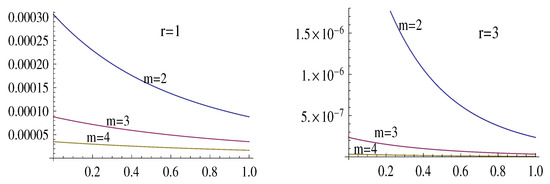Abstract
Sharp, asymptotic estimates of classical and generalized rising/falling Pochhammer’s products having positive arguments are presented on the basis of Stirling’s approximation formula for the function.
Keywords:
approximation; error; estimate; gamma function; inequality; Pochhammer’s product; shifted factorial MSC:
26D20; 41A60; 65B99 (11Y99)
1. Introduction
As a nontrivial example of where we can encounter the Pochhammer product (Leo August Pochhammer (1841–1920), German mathematician known for his work on special functions), let us take the sequence , given recursively as and , for and . The dynamics of this sequence strongly depend on the value of the parameter x and we would like to reveal it. It is easy to see that satisfies the recursion , for . Consequently, we have
Hence, using the total induction, we conclude with the following expression
The product in the numerator of the fraction is called the rising Pochhammer product of order n and basis x. We denote it by . The product in the denominator of is called n-factorial and is denoted by . Thus, and , for integers and any x, when we additionally define , and .
For large n, the fraction in (1) becomes complicated due to the many factors in its numerator and denominator. Thus, it is difficult to directly conclude the dynamics of the sequence as a function of n and x. Therefore, it is imperative to simplify the sequence or find its simple approximation to minimize the error of this approximation. Fortunately, Pochhammer’s product can be expressed with the famous gamma function, denoted by , as . In this way, we obtain the equality (considering the equality ) . Now, using the Stirling formula for approximating the gamma function [1] Sect. 9.5, we can provide the approximation of . The obtained approximation allows us to investigate the dynamics of the sequence as a function of x.
In our contribution, we will illustrate the usefulness of the derived approximation formulas for Pochhammer products using three examples of approximations of binomial coefficients. Namely, for integer , we will obtain the following approximations:
Pochhammer’s products or shifted factorials, falling (lower) and rising (upper), are often encountered in pure and applied mathematics as well as in several exact sciences. For example, the ordinary (Gaussian) hypergeometric function is defined using rising Pochhammer products , and as
The concept of Pochhammer’s product is constantly being generalized, see, e.g., [2].
Pochhammer’s products are found in combinatorics, number theory, probability, statistics, statistical physics, etc. These products are closely related to the famous function, which is also accessible in a numerical sense, see, e.g., [1,3,4,5,6,7,8,9,10,11,12,13].
As we have already said, the classical rising Pochhammer’s product of the order and the basis ,
can be expressed, for , in terms of the function as
There are only a few articles on approximating Pochhammer’s product. One of which is [7], where several approximations of the products in question are provided. In our paper, we would like to present sharper and more general results than those given in [7].
The final equation above suggests the most useful extension of the classical rising discrete-order Pochhammer’s factorial to a continuous-order Pochhammer’s factorial by setting the following definition.
Definition 1.
The rising Pochhammer’s factorial is defined as
Obviously, and , for .
Lemma 1.
For , we have
Proof.
Considering Definition 2, we have, for ,
The classical falling Pochhammer’s product of order and basis ,
can be expressed by the rising Pochhammer’s factorial, as
for an integer n and a real x satisfying . Therefore, we extend the domain of the falling Pochhammer’s factorial to a continuous case setting
Moreover, as , for , we set the next definition.
Definition 2.
The falling Pochhammer’s factorial is defined as
Obviously, and , for .
2. Auxiliary Result (Approximation of Function)
The Stirling approximation formula of order for the function says that for , we have [1] (Sect. 9.5)
where
and, for some ,
The numbers , , , …are known as the Bernoulli coefficients (the positive numbers are called the Bernoulli numbers.). We have, for example,
with the estimates , , , , , , .
As a consequence, we have for the (continuous) factorial function the following expression (the Stirling factorial formula)
3. Approximations to Pochhammer’s Products
3.1. Approximation to Rising Product
We are now able to prove our main result: a theorem on the asymptotic approximation of the generalized Pochhammer’s rising product.
Theorem 1.
For and for integers , the equality
holds, where, (considering , by definition)
and, uniformly in p,
Proof.
Example 1.
For , we have
and
with .
For and any integer , we obviously have . Moreover, setting and in Theorem 1, we obtain a more accurate estimate, given in the next corollary (which can be improved by increasing m).
Corollary 1.
For , the following inequalities hold:
Figure 1 illustrates (all figures in this paper are produced using Mathematica [14]) relations (18) and (19) by plotting the graphs of the functions and , together with the graph (continuous line) of the function , which nearly coincides with the function .
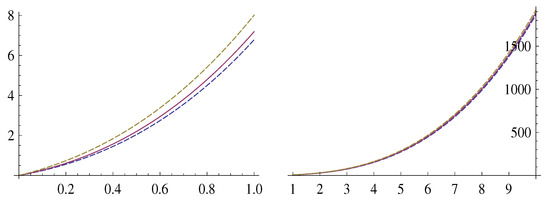
Figure 1.
The graphs of the functions , and from Corollary 1.
Remark 1.
In Formula (15), m and r are the parameters that affect the error term . We stress that becomes very large for large r. Indeed, according to [3] (23.1.15), we have
In addition, referring to (6) and (8), or using [15], we have the double inequality
Consequently,
Thus, considering (15), we find (considering the estimate , for )
Corollary 2.
For and for integers , satisfying , the approximation , given in Theorem 1, has the relative error
estimated as
Proof.
The immediate consequence of Corollary 2 is the next corollary.
Corollary 3.
For and for integers , satisfying , the inequalities
hold.
Example 2.
Setting and in Corollary 3 we obtain the following double inequalities:
true for and , and
valid for and .
The inequalities in (29) are illustrated in Figure 2, where the dashed line represents the graph of the function and the continuous line, compressed between the nearly coinciding graphs of the functions , represents the graph of the function .
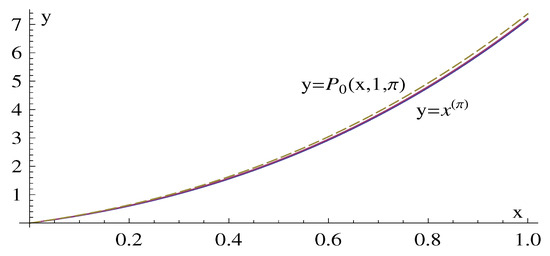
Figure 2.
The graph of the function (dashed line) and the practically coinciding graphs of the functions (continuous line).
3.2. Dynamics of the Sequence
We are interested in how the sequence varies. Indeed, thanks to Theorem 1, for and integers , we have
Therefore, for integers and , for real , and for the difference ,
using (15), we estimate
The inequalities (32) can be used to estimate the error by using the appropriate , which specifies a negligibly small (see (23)) and, thus, provides a useful estimate for . Figure 3 and Figure 4 illustrate the estimate (32), for , by showing the graphs of the functions (with ) and , cramming the graphs of the functions .

Figure 3.
The graphs of the functions .

Figure 4.
The graphs of the functions .
3.3. Approximation to Continuous Factorial Function
For , the quantity is called p-factorial. The discrete factorial function is extended continuously, for real , as . Immediately, from Theorem 1, we read the next corollary, which presents a formula for that does not contain the constant , compared with Formula (10).
Corollary 4
(approximation of the continuous factorial function). For and integers , we have (taking into account the definition .)
for some from the interval .
3.4. Approximation to Falling Product
Using Definition 2 and Theorem 1, we obtain the approximation of the generalized Pochhammer’s falling product, presented in the next theorem.
Theorem 2.
For real , satisfying and for integers , we have the equality
where , that is
with defined in (14), and
Remark 3.
For and any integer p, satisfying , we obviously have . In addition, using the inequality , true for , from (35), we obtain
Thus, for all integers and , such that , we have a rough estimate (interesting for a larger m)
Using Definition 2 and Corollary 3, we read the next result.
Corollary 5.
For real satisfying and for integers , such that , the inequalities
and
hold.
Thanks to Corollary 5, the approximation has a relative error estimated as
true for that meet all conditions given in Corollary 5.
4. Examples of Using Approximation Formulas
According to (4), the binomial coefficient “x over n”,
can be expressed using the upper Pochhammer’s product ac cording to the following Proposition.
Proposition 1.
For every real x and any integer , we have (for , the floor symbol means the integer part of x.)
Proof.
The first and last cases are obvious. Relating to the second one, for , we have (considering the equality , for , true by definition)
Thanks to Proposition 1, Theorem 1, and (10), we present the following three examples.
Example 3.
Using and in Theorem 1 and in (10), we obtain, for some and , the following relations:
Thus, for every and some and , we have
Hence,
Figure 7 shows the graphs of the sequences and , left and right, respectively.
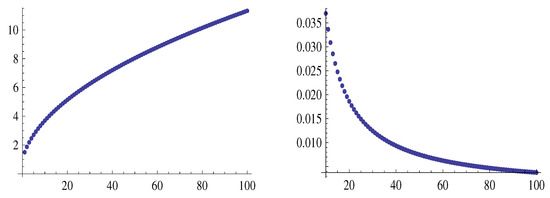
Figure 7.
The graphs of the sequences and , left and right respectively.
Example 4.
Setting and in Theorem 1 and (10), we obtain, for some and , the next equalities:
Therefore, for any , using some and , we find
Hence,
Figure 8 shows the graphs of the sequences and , left and right, respectively.
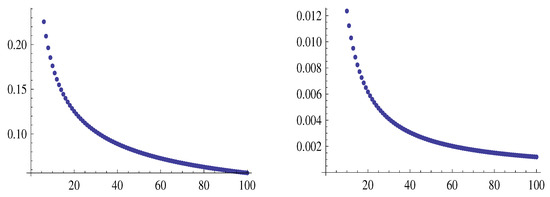
Figure 8.
The graphs of the sequences and , left and right, respectively.
Example 5.
Using and in Theorem 1 and in (10), and considering Example 4, we have (using the identity )
for some and . Thus, for every , there exists some and some , such that
Consequently,
Figure 9 shows the graphs of the sequences and , left and right, respectively.
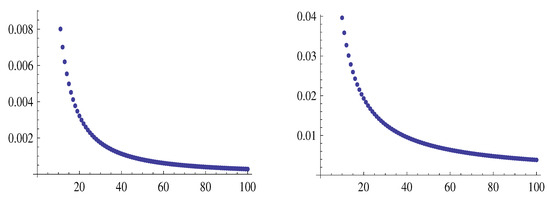
Figure 9.
The graphs of the sequences and , left and right respectively.
Remark 4.
More about binomial coefficients can be found in [16].
5. Conclusions
In this contribution, we provided the approximations to generalized (classical) rising and falling Pochhammer’s products: and . The relative errors and of these approximations were estimated as
In this paper, we also illustrated the usefulness of the derived approximation formulas with three examples of approximations for binomial coefficients.
Funding
This research received no external funding.
Data Availability Statement
Data are contained within the article.
Conflicts of Interest
The author declares no conflict of interest.
References
- Graham, R.L.; Knuth, D.E.; Patashnik, O. Concrete Mathematics: A Foundation for Computer Science; Addison-Wesley: Reading, MA, USA, 1994. [Google Scholar]
- Srivastava, R. Some Generalizations of Pochhammer’s Symbol and their Associated Families of Hypergeometric Functions and Hypergeometric Polynomials. Appl. Math. Inf. Sci. 2013, 7, 2195–2206. [Google Scholar] [CrossRef][Green Version]
- Abramowitz, M.; Stegun, I.A. Handbook of Mathematical Functions, 9th ed.; Dover Publications: New York, NY, USA, 1974. [Google Scholar]
- Alzer, H. Sharp upper and lower bounds for the Gamma function. Proc. R. Soc. Edinb. Sect. Math. 2009, 139, 709–718. [Google Scholar] [CrossRef]
- Chen, C.P. A more accurate approximation for the gamma function. J. Number Theory 2016, 164, 417–428. [Google Scholar] [CrossRef]
- Henrici, P. Applied and Computational Complex Analysis; Wiley: New York, NY, USA, 1977; Volume 2, Section 8.4. [Google Scholar]
- Lampret, V. Approximating real Pochhammer products: A comparison with powers. Open Math. (Cent. Eur. J. Math.) 2009, 7, 493–505. [Google Scholar] [CrossRef]
- Mahmoud, M.; Alsulami, S.M.; Almarashi, S. On Some Bounds for the Gamma Function. Symmetry 2023, 15, 937. [Google Scholar] [CrossRef]
- Olver, F.W.J. Asymptotics and Special Functions; A.K. Peters Ltd. (AKP Classics): Wellesley, MA, USA, 1997. [Google Scholar]
- Whittaker, E.T.; Watson, G.N. A Course of Modern Analysis, 4th ed.; Cambridge University Press: Cambridge, UK, 1950. [Google Scholar]
- Yang, Z.H.; Chu, Y.M. Asymptotic formulas for gamma function with applications. Appl. Math. Comput. 2015, 270, 665–680. [Google Scholar] [CrossRef]
- Yang, Z.H.; Tian, J. Two asymptotic expansions for Gamma function developed by Windschitl’s formula. Open Math. 2017, 16, 1048–1060. [Google Scholar] [CrossRef]
- Yang, Z.H.; Tian, J.F. An accurate approximation formula for gamma function. J. Inequal. Appl. 2018, 2018, 56. [Google Scholar] [CrossRef] [PubMed]
- Wolfram, S. Mathematica; Version 7.0; Wolfram Research, Inc.: Champaign, IL, USA, 2008. [Google Scholar]
- Robbins, H. A Remark on Stirling Formula. Am. Math. Mon. 1955, 62, 26–29. [Google Scholar]
- Lampret, V. Accurate approximations of classical and generalized binomial coefficients. Comput. Appl. Math. 2024, 43, 341. [Google Scholar] [CrossRef]
Disclaimer/Publisher’s Note: The statements, opinions and data contained in all publications are solely those of the individual author(s) and contributor(s) and not of MDPI and/or the editor(s). MDPI and/or the editor(s) disclaim responsibility for any injury to people or property resulting from any ideas, methods, instructions or products referred to in the content. |
© 2025 by the author. Licensee MDPI, Basel, Switzerland. This article is an open access article distributed under the terms and conditions of the Creative Commons Attribution (CC BY) license (https://creativecommons.org/licenses/by/4.0/).

